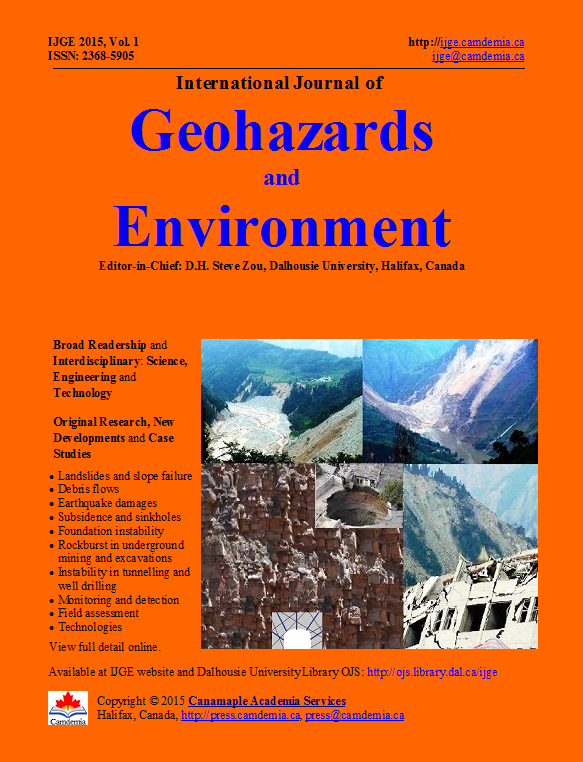Stability Analysis of an Expansive Clay Slope: A Case Study of Infiltration-Induced Shallow Failure of an Embankment in Regina, Canada
DOI:
https://doi.org/10.15273/ijge.2015.01.003Keywords:
expansive soils, shallow slope failure, snow melting infiltration, cracks, coupled hydro-mechanical model, bimodal permeability function, factor of safety, Regina clayAbstract
An expansive clay slope in Regina, Canada that failed in the spring of 1973 is reanalyzed using a comprehensive numerical procedure that involves the coupled hydro-mechanical finite element analysis. This procedure reliably simulates the behavior of the slope for computing its factor of safety (FS) under snow melting infiltration condition. The results of the study show that a bimodal permeability function with an increased saturated coefficient of permeability by 2-3 of magnitudes in comparison to the laboratory measured value can be used to reasonably describe the hydraulic properties of unsaturated cracked expansive soils and the effect of cracks on slope stability. An increase in saturated coefficient of permeability (up to the rate of snow melting) and use of residual shear strength parameters contribute to early failure of this slope under snow melting condition. The study highlights the use of field saturated coefficient of permeability and bimodal permeability function such that expansive soil slope stability can be reliably estimated.Downloads
Issue
Section
License
Copyright, Terms and Conditions
The International Journal of Geohazards and Environment (the Journal) is published by Canamaple Academia Services (the Publisher) online with open access, under a Creative Commons Attribution-Noncommercial license (CC-BY-NC) (http://creativecommons.org/licenses/by-nc/4.0/). Authors (the Authors) submitting papers (the Work) for publication in the Journal automatically agree to the following terms and conditions.
1. Under the license (CC-BY-NC), Authors give permission for others to share and reuse the Work, as long as the original source and author(s) are properly cited (i.e. a complete bibliographic citation and link to the Journal website) and the material is not used for commercial purposes. Any sharing or reuse must however indicate the original CC-BY-NC license terms of the work.
2. Authors transfer and assign to the Publisher all copyright in and to the Work. However Authors retain all proprietary rights except the copyright, related to the Work and also retain the rights a) to use, reproduce, distribute, and publicly display the Work in any medium in connection with the Authors‘ academic and professional activities, such as teaching, presentations and lectures, b) to create derivative works from the Work and to make full use of the Work in future research and publications, c) to authorize others to make any non-commercial use of the Work, d) to make both the pre-published and final-published versions available online in institutional and/or disciplinary repositories or on their own websites with a citation and link to the original paper published in the Journal.
3. Authors warrant that the Work is their original work, it is not copied from anywhere or anyone else, they are totally responsible for the authenticity, originality, validity and accuracy, and the facts and views are their own, that the Work contains no matter which is defamatory or infringes any literary or proprietary rights, intellectual property rights, or any rights of privacy, and that the Work has not been simultaneously submitted to any other journals or publishers. Authors further agree that their manuscripts whether accepted or rejected will not be returned and the rejected manuscripts will be disposed at the journal editor's discretion.
Disclaimer: The Publisher, the Journal and the editors accept no responsibility for statements or opinions expressed by authors. Use of information and materials in the Journal is the sole responsibility of users.


